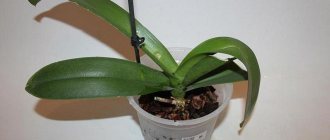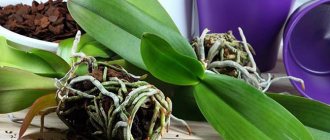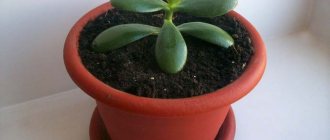Do you have an orchid growing, but you don’t know how to replant it at home? Read the article, it contains a lot of useful tips and instructions.
The orchid, just like the rose, can be called the queen of flowers. Graceful flowers, decorative leaves, intertwining roots and stems create a plant of incredible beauty. But this flower, like all the others, needs good care, an important component of which is replanting. It needs to be done correctly and on time - the further development of the plant and the abundance of flowering, as well as the duration of the adaptation process, depend on this.
Read another article on our website that tells how to propagate an orchid at home with children, cuttings, roots, and seeds. All methods are described in detail.
This article describes the timing, as well as the rules for transplanting a home orchid. You will learn how to replant a flower after the store and why to do it at all. Read on.
Why replant an orchid when grown at home: is it replanted at all, is it possible?
Orchid transplantation at home
Various circumstances may arise under which a transplant is performed. Why replant an orchid when growing it at home? Is it possible to replant at all? Yes, this can and should be done. Here are the circumstances under which flower breeding experts advise doing this:
- Replanting is required once every 3-4 years after purchasing or replanting the plant.
- If it is noticed that the roots have begun to appear from the pot, i.e. it has become too small for the plant.
- If the orchid is very sick, all its leaves begin to turn yellow.
- Unsightly appearance and condition of the substrate in which the flower grows. Mold or severe dryness of the upper fragments has appeared on the surface, which indicates a loss of the filler’s ability to pass water and air.
- The plant does not bloom for several years, and then it needs a good shake-up in the form of a transplant.
- If necessary, divide the orchid.
If these signs are not observed, it is better not to touch the orchid - it does not really like to be disturbed. It is also not recommended to do this during the flowering process; it is better to wait until it is over, unless an urgent transplant is needed.
Tools and materials
Having an abundance of tools and materials will make your job and adaptation period much easier. For a convenient transfer you will need:
- sharp pruning shears or knife;
- scissors;
- suitable pot;
- special soil;
- charcoal or activated carbon;
- gloves;
- drainage;
- sphagnum moss;
- peduncle holder if necessary.
Timing: when can an orchid be replanted?
Replanting an orchid at home
This operation should be carried out when the dormant period of the inflorescences and the entire plant has ended. But there are types of orchids in which the dormant period is weakly expressed, for example, phalaenopsis, which blooms almost all year round with short breaks. Therefore, if new shoots of a plant do not develop in the absence of signs of disease, it means that it is entering a dormant period. This is the best time to replant. This time usually occurs in the spring - late February and March. This is the best time to replant an orchid.
What should be in the correct composition and how to prepare it yourself?
Making a flower composition with your own hands gives you confidence in its high quality. In addition, you can select individual components for a specific type of plant.
Basic components suitable for many types:
- tree bark;
- sphagnum moss;
- coal;
- expanded clay or perlite for drainage.
Sometimes peat, sand and coconut fiber are added. These ingredients are mixed in certain proportions suitable for a particular type of orchid.
You can find out what ingredients to choose for preparing your own soil in this article.
Frequency of orchid transplantation at home: how often?
Replanting an orchid at home
Many novice flower lovers ask the question: “How often to replant an orchid?” . What determines the frequency of transplanting inflorescences at home?
- The answer to this question depends on what composition of the substrate is in the container.
- It may consist of moss, and then it needs to be replanted more often - once every two years .
- If the main part of the substrate is bark, which decomposes more slowly, then you can replant it once every three years.
Of course, these dates are indicated for planned replantings, when the inflorescence looks completely healthy and has no signs of damage by insects.
Room care after and when to water?
Transplantation is a huge stress for the plant. To carry out the procedure without undesirable consequences, you should follow some rules.
- After the process, give time to adapt to the new home conditions.
- Watering should be done after 10-14 days so that the wounds on the roots heal and heal.
- The temperature must be maintained at + 18-21 degrees.
- It is worth fertilizing and fertilizing no earlier than a month later.
Substrate for orchid transplantation at home: what is it made of?
Substrate for transplanting orchids at home
To transplant orchids at home, you need to choose a high-quality substrate. The health and further flowering process of the plant largely depends on this. What is it made of? You can buy a specialized one at retail outlets, but it comes in two types:
- For epiphytic (i.e. with aerial roots). It's called Phalaenopsis Mixture.
- For terrestrials - “Mixture for Cymbidium”.
The first mixture is used for flowers growing on trees with long aerial roots. Therefore, the substrate for them must be breathable, because the roots of these flowers take part in photosynthesis and they do not need soil, only moisture, to grow. The composition of such mixtures usually includes:
- Pine bark
- Ground fern root
- Activated carbon
- Cut cork
- Sphagnum in small quantities
The second type of mixture is denser, because it is intended for orchids living on the ground. It contains more of these ingredients:
- Sphagnum moss
- Lowland peat
- Leaf ground
- Coal
Sometimes various synthetic materials, such as perlite or foam, are used as a substrate. You can also use:
- Expanded clay
- Shell rock
- Pumice
The substrate can be made at home. Pine bark is used for this:
- First disinfect it - hold it over steam for half an hour or boil it in water.
- After this, dry and boil again. This treatment kills all pathogenic organisms.
- Place to dry again and then cut into pieces up to 2 cm .
To the bark prepared in this way, add dry and finely chopped sphagnum moss and just a little peat coal. You can now fill the pots with this mixture.
Which substrate should you prefer?
Which substrate should you prefer? Everyone who has an exotic beauty growing on their windowsill asks a similar question. There is an opinion that the best option is pine bark of medium or fine fraction. Indeed, this soil mixture is considered traditional, but, in addition to it, others are also popular, which recently are increasingly found on the shelves of specialized stores.
So, an orchid can be planted in the following types of soil:
- Coconut fiber (sometimes called coconut chips). This substrate is prepared from the outer coconut shell by washing, drying, sterilizing and grinding. The finished particles go on sale. The advantages include affordable cost, organic nature, good moisture holding capacity, excellent aeration and environmental friendliness. The substance can be used both as an independent substrate and as one of the components of the soil mixture. It is worth noting the neutral acidity of the fiber, which is comfortable for root development.
- Compressed coconut. The main difference from coconut chips is that the crushed particles are pressed into briquettes. The advantages include good moisture holding capacity, aeration, environmental friendliness, and organicity. The substance has an affordable price, which is important for many gardeners. This substrate is most often used for growing orchids on blocks, that is, several pieces at once (soil mixture in the form of compressed coconut - the main soil), or as an additional secondary component of the soil.
- Peat (high fibrous, or red). The substance is old, but not rotten, sphagnum moss, which has accumulated for centuries at the bottom of the swamps. Its main advantage is the slow decomposition process (compared to pine bark), and its disadvantage is its excessive moisture capacity and ease of drying. To grow an orchid in a peat substrate, you need to maintain soil moisture at 60%-65% and ensure that the acidity level does not exceed 5.5-6.5 units.
- Sphagnum moss (New Zealand moss is preferred). Often acts as a top layer, which is necessary to retain moisture. However, recently the product can also be used as a base for soil. Its advantage is its excellent moisture capacity, which makes it easy to grow any orchid on moss, for example, epiphytic, terrestrial, and even seedlings. The only difficulty in this case will be maintaining the life of the moss itself. The latter largely comes down to the need to use only high-quality and purified water, which is as free as possible from harmful salts and any other impurities.
- Expanded clay, ceramis, perlite, vermiculite, pumice, coarse sand, gravel. In most cases, the selected substance is used as a drainage layer up to two centimeters thick. Expanded clay, pumice, ceramis and vermiculite are porous and lightweight substrates, characterized by their ability to retain water and excellent aeration. All other substances are used in the absence of light porous materials to create a drainage layer.
- Man-made fibre, such as mineral wool or dolomite. The latter serves as an additive that reduces the acidity of the substrate. Often the product is added at the rate of 1 gram of product per 1 kilogram of substrate.
- Charcoal. This is one of the additional components of the substrate (usually the additive is not used in an amount greater than 10% -20% of the total volume of the soil mixture). Its advantage lies in the fact that the substance is an excellent adsorbent, which has the ability to absorb any phenolic-type compounds that are invariably formed during the decomposition of organic soil. When choosing charcoal, you need to pay attention to acidity (it should be at the level of 5.5-6.5). The advantages of charcoal include excellent aeration (which is very important for orchids), resistance to decomposition, and resistance to water absorption and retention.
You can learn a little more about what substrates exist and how to properly compose them for successful orchid growing by watching the video.
Remember that, no matter how good the soil for an orchid, the success of growing depends on proper care of the plant. Do not forget about the need to maintain a comfortable temperature (22-26 degrees), humidity (50%-60%), lighting (at least 8-10 hours of soft diffused light). And also keep your exotic beauties away from heating devices, ensure proper watering and eliminate the possibility of direct sunlight hitting the leaves of the plant.
Which pot is best to replant a home orchid?
It is better to replant the orchid in a transparent pot.
Most orchids have large roots that like to entwine the pot from the inside and even look out. Therefore, when choosing a new container for a flower, you need to focus primarily on the size of the root system. But, given that the base of the flower will grow further, you need to add a few centimeters to the diameter. Which pot is best to replant a home orchid?
Worth knowing: For a large orchid with intensive growth, you can buy a pot, as they say, “for growth,” so as not to replant it often.
Orchid lovers most often grow their “beauties” in plastic transparent pots or containers. What are the advantages of such containers? Here is the answer:
- The roots are clearly visible and you can constantly monitor their condition. With normal soil moisture, the roots are usually green, but as the substrate dries, they gradually turn gray, which indicates the need for watering.
- In plastic containers, unlike clay ones, the roots do not grow to the walls of the container and therefore are not injured during replanting.
Although clay containers have their advantages:
- In them, the base-root does not overheat, which is very important for orchids.
- Do not overwater the plant because the moisture will last longer.
- In addition, a clay pot is much heavier than a plastic one and therefore will not tip over. Orchids are planted in such pots, some of the roots of which completely dry out and die during the dormant period.
Be sure to make drainage holes in the containers. This will provide the roots with faster drying and ventilation, which will protect them from rotting. Flower lovers with no experience often overwater the plant for fear of drying it out. Drainage holes will help in this case too.
Worth knowing: Plastic containers have one drawback - they have a rather simple, not very sophisticated appearance, compared to the flower itself. To correct this shortcoming, you can buy a beautiful flowerpot that will completely hide the plastic.
There is another way out - you can put a plastic pot in a low glass vase. The space between the walls of the vase and the pot is filled with some kind of jewelry or tinsel, balls or floral fillers. This needs to be done carefully so that the multi-colored filler does not distract from the beauty of the orchid flowers.
Remember: Do not buy large containers for orchids. In small ones - up to 15 cm in diameter, it feels much better and blooms longer.
Preparing for transplant
Choosing a pot
Plastic transparent pots are most suitable for orchids. The roots will have access to light and participate in photosynthesis, which means they will additionally nourish the plant. And you can see through the transparent walls how dry the bark is after watering, and whether there is condensation inside. And also notice diseases or pests in time.
An important nuance: the pot should have many drainage holes at the bottom. This will allow water to flow out immediately when watering, without stagnating at the roots. It is also very desirable to have holes on the walls of the selected container, especially in its lower part - for ventilation and better air circulation in the substrate.
Ventilation holes in the orchid pot will allow the roots to breathe fully.
If you bought a plastic pot, but there are not enough holes in the bottom and walls, make them yourself. For example, using a hot awl or screwdriver.
Plastic containers may seem inconspicuous, but this is only at first glance. In fact, they can be quickly transformed by installing them in any decorative flowerpot.
Another option is ceramic (clay, terracotta) pots. They may also have ventilation holes on the walls and drainage holes on the bottom. And at the same time they look quite decorative, especially specimens with a glazed coating. A significant disadvantage of such containers is their porous structure, to which orchid roots grow tightly. And when transplanting them you have to either cut them off or break the pot.
Orchids are also grown in glass pots, plastic lattice containers, wooden or metal baskets. You can choose any of these options.
Note!
The new pot into which you will move the orchid should be slightly larger than the previous one - 2-3 cm in diameter. If the old pot has not yet become crowded, you can leave it, replacing only the soil when replanting.
Choosing the right substrate
Let us remember that phalaenopsis orchids are epiphytes. Therefore, ordinary peat soils are not suitable for them. They need a special environment that creates “airy” conditions, allowing the roots to ventilate and dry quickly after watering.
The store sells ready-made soils for orchids. Typically this is a mixture consisting of pine bark and various additives: sphagnum moss, charcoal, perlite, coconut chips and coconut fiber.
Substrate for orchids, composition: pine bark, expanded clay, coal, sphagnum moss
Often the composition contains peat. However, substrates with added peat should be avoided; it makes the mixture too dense, unsuitable for “breathing” epiphytic roots. As a last resort, if you purchased such a soil mixture for replanting, select the appropriate components from the package, and leave the peat component for other flowers.
You can also make your own soil for orchids. Often among gardeners, only one component is used - pine bark, cut into 1-1.5 cm cubes. And no additives! Phalaenopsis grows well in solid bark. For example, the well-known soil “Orhiata” consists of pine bark - and nothing else.
However, if desired, you can mix the following with the bark:
- Sphagnum moss – it makes the mixture more moisture-absorbing and can be useful in dry, hot growing conditions. Often sphagnum is not added directly to the substrate, but is laid on top of it to maintain the moisture of the aerial roots.
- Pieces of polystyrene foam - this component, on the contrary, does not absorb water at all. During transplantation, foam is often placed under the neck of the orchid to reduce the likelihood of rotting. It can also be used as drainage or an additional loosening component.
- Charcoal - used to disinfect the substrate. There is no need to add a lot of it; 5-10% of the total volume of soil is enough.
- Expanded clay – has good moisture capacity and breathability. Sometimes phalaenopsis is grown in pure expanded clay, using it as a complete alternative to bark.
- As well as other components: zeolite, foam glass, clay granules, etc.
How to transplant children, one child, a shoot of a home orchid: step-by-step instructions
Replanting a baby home orchid
An orchid growing in normal, ideal conditions can produce young shoots, or babies. This is a great opportunity to propagate the plant. What should be done? How to transplant children, one child, a shoot of a home orchid? Here are the instructions step by step:
- The baby should have fairly long roots - more than 5 cm and 3-4 leaves - these are the most suitable parameters for transplantation.
- Children usually appear on the stem or near the root collar. Using a sharp knife, you need to cut off part of the stem with the baby, stepping back to the sides at a distance of about 1 cm . Sprinkle the cut area with coal.
- Prepare a small glass in advance, preferably a plastic one, and add a small layer of drainage.
- Place the baby in a glass and carefully cover it with substrate. for the first 3-4 days .
- Place the glass with the baby in a place where the air humidity is high. You can simply spray the surface of the window sill where the glass is located more often. Try not to get it on the leaves.
The baby will grow in such a container for about a year, after which it can be transplanted into a larger container. An orchid grown from a child will bloom in three years .
Preparing the root system
Before replanting the orchid, be sure to rinse the entire root system in warm water to get rid of adhering soil residues. Using a sharp knife or garden shears, cut off all rotten, dry and damaged fragments. Sprinkle the cuts with crushed charcoal or treat them with special floral antiseptics. Dry the plant for 10-20 minutes on a paper towel.
Photo: greensotka.ru
Further proper care of the phalaenopsis orchid plant after transplantation, growing conditions
After replanting, you need to provide proper and timely further care for the orchid. Here are the conditions for growing a phalaenopsis orchid plant:
Proper care of an orchid is to shade the window so that the sun does not burn the leaves of the flower.
- As mentioned above, immediately after the transplantation is made, the container is placed on a sunny windowsill for a week, but shaded from direct sunlight. Otherwise, if this is not done, the orchid leaves will lose their decorative appearance, wrinkle and become wilted.
You can water the flower after transplanting only after a couple of weeks.
- water the plant after replanting only after 2 weeks . The fact is that orchid roots are susceptible to various fungal diseases. Therefore, the root system needs to be slightly dried to avoid this. Find out how to properly water an orchid here .
Spraying the plant so as not to dry it out
- But, in order not to dry out the plant, spray the leaves, or, even better, wipe them with a wet sponge. In this case, under no circumstances should water get into the depths of the rosette of leaves. This can lead to their rotting.
Orchid grows at optimal temperature
- It is important to maintain optimal temperature. The orchid does not like heat, it needs a temperature no higher than +21-22°C , but it should not fall below 18°C . Otherwise, the inflorescences get stressed, which is very undesirable for these sissies.
Feed the orchid
- A blooming orchid needs feeding. Use only mineral mixtures. Organic ones are not suitable for feeding flowers, since they can introduce diseases into the soil.
Excessive nitrogen nutrition can cause leaf growth to the detriment of flowering. Nowadays you can find special fertilizer compounds for orchids in stores. In any case, it will be good to use an all-purpose fertilizer for flowering plants. They must be diluted strictly according to the instructions so as not to harm the flower. They need to be added along with water for irrigation.
Care
The orchid requires light shading in the next week. Transplantation and care do not cause serious difficulties. Immediately after transplanting, the plant is watered abundantly. The water should be purified and at room temperature. A small amount of nitrogen, potassium and magnesium is added to it.
The pot with the plant is immersed in this solution for half an hour. The next watering is carried out no earlier than after 2 weeks. The first feeding is introduced 3 weeks after transplantation. These simple recommendations will help create the right conditions for growing a beautiful flower.
If there is no flowering after transplantation: what to do?
Lack of flowering after transplantation
After transplantation, the orchid should increase its green mass and bloom after a certain time. This usually happens after 3-4 months . But what if the inflorescences do not appear for much longer? What to do if there is no flowering after transplantation? This problem can occur for several reasons:
- The plant is overfed with nitrogen fertilizers , active leaf growth is observed, they become larger than they should be during normal development. In this case, feeding should be stopped for a month.
- The transplant was not carried out in a timely manner . For example, if for some reason an orchid was transplanted at the time when it bloomed last year, then it most likely will not bloom this year. The plant will direct all its energy to restoring its root system, and not to flowering.
- Perhaps you made mistakes during transplantation . If the plant is not firmly fixed in the substrate, then when you move the pot, it begins to dangle in it, and the roots and stems will receive microtrauma. The plant does not have the opportunity to direct its energy to flowering, experiencing constant stress.
- Insufficient lighting and low humidity . You need to move the pot to a lighter windowsill and spray its surface to increase the humidity of the surrounding air.
Follow these tips, and your flower will soon delight you with its unique blooms. It's worse when the plant begins to wilt. What to do? Read on.
The process of a diseased plant with rotten roots or without them at all
Sometimes, after large-scale pruning of the root system from rotten, soft and dry areas, the size of the roots decreases significantly. To disinfect and disinfect the roots of a diseased orchid, they must be soaked in a “Fitosporin” solution.
If the plant has no roots at all, then urgent resuscitation is needed to save it. The system can be expanded in or above water, in a greenhouse, in expanded clay, or in a substrate. The duration can take from a month to a year.
What to do if your home orchid withers after transplantation?
A home orchid withers after transplantation.
Most likely the plant is sick. If planting rules are violated, when mechanical damage to the roots occurs, the leaves do not receive full nutrition. What to do if your home orchid withers after transplantation? Here are the tips:
If you watered a lot, replant the plant:
- With good watering and stagnation of liquid at the bottom of the container, especially if there is no drainage, the roots may begin to rot.
- Then the wilting will soon be replaced by yellowing of the leaves and the plant may die.
- Here an emergency orchid transplant will be needed to save it.
Control pests:
- Another reason could be a pest attack.
- Spider mites, the worst pests of indoor plants, thrive in dry air.
- It can be difficult to notice them right away - they are very small and the bad effects begin to appear when there are a lot of them.
- Whiteflies and scale insects also harm orchids. Providing optimal air humidity will help to significantly reduce the number of these insects.
Protect from the sun:
- If the orchid is not protected from direct sunlight, its leaves will begin to wilt.
- This indoor flower feels best on windows that face east, where the sun appears only in the morning and for a short time.
Containers must be provided with drainage holes, and they need to be made not only at the very bottom of the container, but also on the sides to ensure good air exchange for the roots.
Soil requirements
Garden soil is not suitable for an orchid - it is too heavy and the roots will quickly rot. You need a special substrate made from pieces of oak, aspen or pine bark. You can use fern roots, charcoal, moss, cork or foam chips, pieces of chalk, granulated clay or perlite. If you prepare the mixture yourself, be sure to first boil the bark twice to kill bacteria, fungus and pests.
Photo: biruzinka.blogspot.com
How to grow an avocado from a seed at home
How to properly water a home orchid flower?
Well-groomed orchid flowers
Watering a home orchid flower is carried out by immersion in water, the temperature of which is not lower than +20°C , so as not to cause stress to the plant. How to do this correctly? Here is the answer:
- To do this, take a cup with warm liquid and place the container with the plant in it for 20 minutes .
- Then take it out and place it on a wire rack to drain off excess water.
- Then place the flower in its usual place.
In winter, the number of waterings should be reduced, but in summer, on the contrary, this should be done more often, at least twice a week. It is necessary to monitor the pseudobulb - if it has lost turgor, then watering is necessary.
Important: It is forbidden to take long breaks between waterings. The orchid is a tropical plant that naturally lives in times of frequent rain and high humidity. Therefore, drought is detrimental to it.
Choosing a pot
Orchids need constant air circulation, and some varieties can even be grown without pots in special blocks. Baskets, wicker flowerpots, and wooden boxes with slots are perfect. A convenient option is a transparent plastic pot with holes on all sides to monitor the condition of the roots and soil.
To make drainage holes in a plastic flowerpot, use a soldering iron or a hot nail. When replanting, fill any new pot one-third full with foam or fine gravel. In the future, when watering, always wait until the orchid has completely drained.
Photo: tchudesa.ru
How to replant an orchid flower if the root is rotten: tips
Replanting an orchid flower if the root has rotted
Infrequently, but there are cases when novice gardeners, as a result of improper care, have the roots of an orchid rot. This can happen to all the roots or to a large part of them at once. Is it possible to save the plant then? How to replant an orchid flower if the root is rotten? Here are the tips:
- To revive orchids whose roots have completely died, you need a small window greenhouse.
- In the container where the leaf rosette will be located, you need to pour a small layer of drainage - this can be expanded clay or pebbles.
- Place sphagnum moss on top, which is previously kept over steam and dried.
- Now moisten the substrate and place the leaf rosette in it.
- Transfer to a greenhouse, where a constant temperature should be maintained within +21 - +27°C and high humidity of about 100% . The light should be bright, but diffused - direct sunlight is detrimental to leaves during this period.
After 3-4 weeks of this regime, root rudiments will begin to appear at the base of the leaf rosette and then they will begin to grow. Epin , to the water for irrigation .
If a diseased orchid has several living roots left, or even just one, the chances of saving it increase:
- After trimming the rotten roots, you need to rinse the remaining living roots under warm water and sprinkle the cut areas with charcoal.
- A pre-prepared pot up to 8 cm in diameter is filled with ordinary substrate and a leaf rosette with roots is planted in it.
- Next, the plant is treated as in the first case, placing it in a greenhouse.
If everything went well, new roots will begin to grow in 2-4 weeks .
Features of growing on blocks
In addition to cultivating orchids in the usual way - in pots, there is such a method as keeping them on blocks. The blocks are compressed bark or cork . The block is covered with sphagnum moistened in water, and orchid roots are placed on it, evenly distributing them around the entire perimeter. The roots are covered with sphagnum on top.
After the block with the orchid is suspended, you should moisten the top layer of moss with water at room temperature from a spray bottle.
Is it possible to replant a flowering orchid while it is blooming?
You can replant orchids during flowering, but in the most urgent cases.
There is only one situation in which you can replant a blooming orchid - if it is in danger of dying for any reason and you need to choose one of two:
- The orchid will fade, but then die, having spent its last energy on flowering.
- The peduncle is cut short, but later with good care, the plant is completely restored and after a while it will bloom again.
What to do in the second case? Adviсe:
- Prepare fresh substrate and pot. How to do this has already been said above in the text.
- Cut the flower stalks of the orchid to about 2/3 of the length. By the way, the flowers can be placed in water - they will last for almost a week.
- Carefully remove the plant from the pot and inspect the roots, cutting out any rotten ones.
- If the substrate is in normal condition, i.e. there is no mold or its smell, it is not overdried or, on the contrary, very waterlogged, then in this case you need to try to preserve it as much as possible without shaking off the roots. Otherwise, proceed as with a regular transplant, the procedure of which has already been described.
- Now you need to place the plant in the pot and secure it well there.
All that remains is to put the orchid, transplanted during flowering, into the greenhouse and observe how it will feel further. Do not forget to follow all the rules for caring for this flower, which are no more complicated than the rules for caring for other indoor flowers.
Important questions
Is it possible to manipulate a flowering plant?
It is highly not recommended to replant a flowering orchid. An exception may be cases of plant disease, when it simply has to be saved.
What to do if the flower withers?
In some cases, after transplantation, the orchid looks sluggish, depressed and does not begin to bloom for a long time. This is due to the fact that the flower is accustomed to the biological and microchemical composition of the old soil, and it takes time to adapt to the new one. Sometimes it is possible to add a few pinches of the old substrate (only if it has not been infected) to the new one to shorten the adaptation period of the orchid.
What frequency should be observed?
The frequency of orchid transplants is no more than once every 2-3 years. A newly purchased flower in a store is replanted either immediately after purchase at the end of flowering, or after 1-1.5 years, depending on the condition of the soil and the plant.
How to seat children correctly?
From time to time, babies appear on the orchid - paired leaves with rudiments of roots. Such shoots are ready for separation and need to be transplanted. You can trim the children when their roots reach a length of 3-4 cm.
- They are taken together with part of the mother plant - 1 cm is cut off from it on each side of the shoot.
- The cut areas are immediately treated with crushed activated carbon.
- Then the babies are soaked for 15 minutes in warm water and transplanted into a pre-disinfected substrate in a manner similar to transplanting adult plants.
Important. Only one sprout is planted in one pot.
An orchid is propagated in this way, using it only after the plant has finished flowering.
This video talks about how to plant orchid babies:
What to do if pests or diseases are detected?
In cases where pests and diseases are detected during phalaenopsis transplantation, it is necessary:
- remove all damaged areas of roots;
- rinse with water;
- dry;
- treat with special antifungal agents;
- Sprinkle the sections with activated carbon powder.
The procedure for transplanting an orchid requires careful attention to following all recommendations and careful handling of this exotic flower. Correct actions will keep the plant healthy, and it will delight with its beauty for a long time.
Is it necessary to replace the soil during replanting?
For any plant, replanting is stressful. As for the orchid, it is replanted every three years with a complete replacement of the soil. During this period of time, the soil loses its original important properties, namely:
- The amount of nutrients in the soil decreases.
- Acidity increases.
- The balance of mineral salts is disrupted.
- The soil begins to have poor air permeability.
- The substrate begins to rot.
For orchids, the main substrate is tree bark . After interacting with water, it swells and collapses. Then the substrate becomes dense, air exchange is disrupted and the plant roots do not receive the necessary dose of oxygen.
For full growth and flowering, soil acidity should be from 5.5 to 6.5 pH. If the acidity level is higher or lower than normal, the orchid leaves will turn yellow, since it will not absorb iron fully.
The orchid should be watered with clean water, because due to poor watering, mineral salts accumulate in the soil. This negatively affects the functioning of the plant roots.











